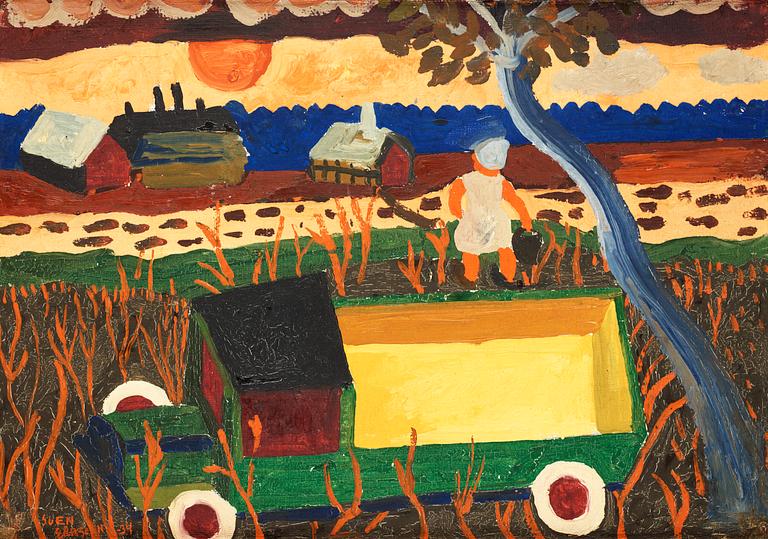Sven X:et Erixson
"Sverres leksaksbil" (Sverre's toy car)
Signed Sven Erixson and dated -34. Panel 34 x 48.5 cm.
Exhibitions
The Swedish Institute, "A Phrase of Swedish Contemporary Art", London 1945.
Liljevalchs konsthall, Stockholm, "Sven Erixson X:et", 12 October – 12 November, 1961, cat no 115.
Literature
Åström, Holmér, Bjurström m fl, Sveriges Allmänna Konstförening, SAK, publication lxxv, "Sven Erixsons konst", reproduced page 133.
More information
1934 flyttade Sven Erixson med sin familj till Bastugatan 15 i Stockholm. Där tillkom kända verk som "Kustbild, östra Skåne", "Hamnen i Nordland" och flera målningar med motiv ur familjens liv, däribland "Sverres leksaksbil". Denna målning tillsammans med med andra familjenära motiv som "Sverres leksaker", "Irma i röd säng", "Sverre målar" blev 1930-talets motsvarighet till Carl Larssons Sundbornskildringar från sekelskiftet.
Designer
Sven Erixson, today more commenly known as X, was born in 1899 in Stockholm. He studied to become a decoration painter and art teacher at the Technical School in Stockholm after which he studied at the Higher School of Art and Design alongside study trips to Germany, France, Italy, Spain and North Africa. Despite being an inportant artist amoungst Swedish art, Erixson does not let etiquette and style limit his painting style. His greatest creation is defined by a tempremental style in stark colour patterns. Erixson's paintings balances between impressive, somewhat brutal expressions and a soft lyricism. He is one of the founders of the group Färg och Form, whose primitivist faction he belonged to. With an aura of narrative joy, Erixson recounts his experiences. He had an irresistable desire to share everything that he saw. He was inspired, much like Bror Hjorth of both folk art and mural painting from the middle ages, while also finding inspiration from German expressionism. But he speaks with greatest esteem about Chaim Soutines art. In a multitude of paintings, he conveyed his zest for life, with surfaces filled with swiftly captured figures. During the 1930s, his visual world was filled with family and the idyllic torpor, his canvas became greater and more complete. During the war he painted on butter paper, not only for practicalities sake, but also to take advantage of the slippery reflective surface which the paper supplies. Narration decreased in the 1950s when he was influenced by spontaneity, which in the following years led him to abstract spontaneous painting.
Read more






























